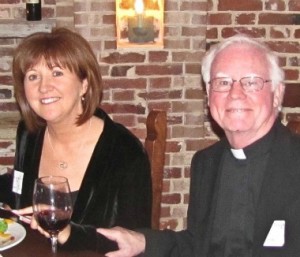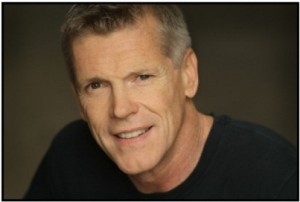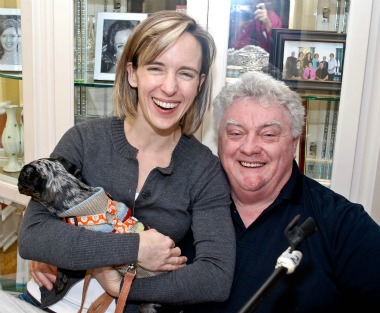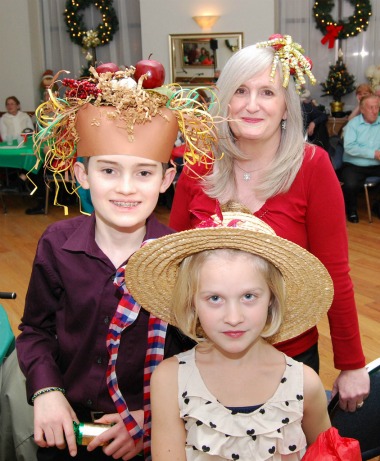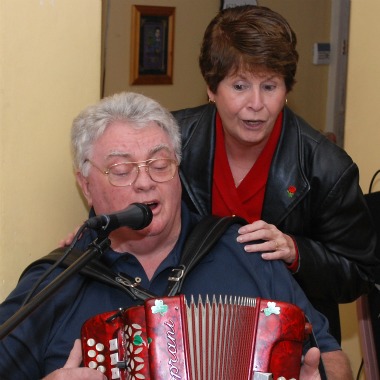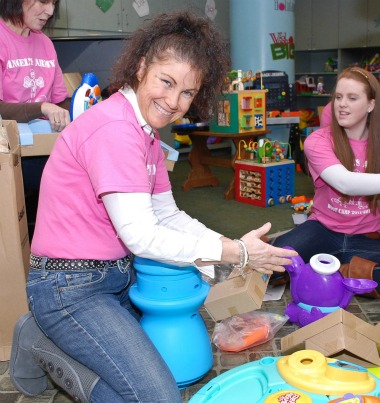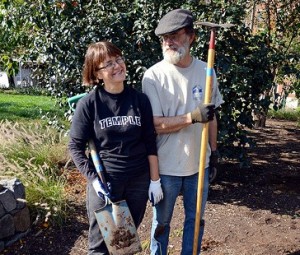
Irish Gothic-Pauline and Peter at the Irish Memorial.
It was a bright afternoon in late October down at The Irish Memorial at Front and Chestnut. Visitors ambled through the park, stopping to take in the massive bronze monument created in memory of those who perished in The Great Hunger.
Wandering in their midst was a crew of volunteers led by landscape architect and native of Ireland Pauline Hurley-Kurtz and Pennsylvania Horticultural Society colleague Julie Snell. Now and again, one of the workers would grab a shovel or a rake from the collection of gardening implements propped against the eight-year-old structure and head off to a bare patch of ground, there to dig holes for the ornamental plantings that surround the monument .. Mexican hair grass, fountain grass, prairie dropseed.
This was one of the two big cleanup days that take place at the monument, preparing the site for winter.
The diminutive, unassuming Hurley-Kurtz has been associated with the outsized, attention-getting Memorial since 1993—ten years before the monument formally opened to the public on the nearly two-acre plot at Penn’s Landing. Of course, the monument sculpted by Glenna Goodacre is the proud centerpiece, but the distinctive plantings, stone walls and standing stones are evocative of the stark landscape of Ireland. The grass and stone are every bit as steeped in meaning as the bronze.
We were curious to know more about these aspects of the site that visitors might overlook—the plantings, walkways and other elements that together work with the monument to create a unified whole.
Pauline Hurley-Kurtz was born in County Monaghan and grew up in Dundalk, County Louth, the daughter of John and Josephine Hurley. With a degree in horticulture from University College, Dublin, she came to Philadelphia to go to graduate school in landscape architecture in Penn. She is now a tenured faculty in the landscape architecture and horticulture at Temple, and is married to Peter Kurtz, whom she met—appropriately enough—at Bartram’s Garden.
In 1993, the Memorial committee invited her to develop a concept landscape design. Here’s what Hurley-Kurtz had to say about herself, her work, and her role as design landscape architect for the Irish Memorial.
Q. A lot of memorials—maybe most memorials I’ve seen in the city—are just surrounded by an expanse of lawn. The Irish Memorial is very different. I’m curious to know a bit about the background. Someone somewhere must have been thinking early on about the landscape and how it would play off the memorial.
A. My ideas for the memorial landscape grew from a wish to express the Irish landscape and culture in the memorial space. I included stone walls and standing stones. The standing stones include the Irish, English and Ogham languages. I included patterns from Newgrange on the information panels. A stone from Croagh Patrick was included in the St. Patrick’s planter. The planting design included hedgerows reminiscent of the the Irish landscape to the east and a woods edge planting reflecting the Pennsylvania Piedmont to the west.
Q. When we talk about landscape, we’re not just talking about the plants, are we? How much did you have to do with the overall layout of the park surrounding the memorial … paths and so on? And how did you come to think about how all of it would hang together, to draw visitors to the memorial and add to the experience?
A. The most important goal was to create a space for the memorial sculpture—a simple uncluttered space with darker stone for the plinth and ground plane. After that I had to consider views and access—hence the two main diagonal entry paths each with its own theme of Hunger and Arrival. Then the grading, manipulation of slopes and addition of a couple of steps into the adjacent turf areas. Also, we kept much of the area adjacent to Chestnut Street on the bridge open to afford views into the sculpture from cars, buses and for pedestrians. It also provided clear views towards the Benjamin Franklin Bridge from within the Memorial space. Of course, views into and from an urban park are always important.
Q. Did anything about the memorial itself dictate to you what the surrounding landscape would look like? And did you have to think about how it all would fit into the riverfront/old city area? Were there any restrictions on what you could do?
A. The memorial sculpture by Glenna Goodacre has three major themes—the Great Hunger in Ireland; mass emigration; arrival and hope in Philadelphia. We oriented the sculpture so the Irish theme would be a focal point for the path from Penn’s Landing and the Philadelphia theme would be seen first from the Front Street path. That also coincided with optimal passive solar orientation to minimize shadows from the north. There were physical restrictions as to the weight of the sculpture—it need to be placed adjacent to one of the main bridge support beams. There were very few design restrictions. We wanted to use the best quality materials—natural stone—and to create a simple space in the round for the sculpture and to create an opportunity for reflection.
Q. Tell me how you continue to be involved in the memorial.
A. Since the Irish Memorial dedication in 2003 I have worked with the Irish Memorial, Inc., and the Pennsylvania Horticultural Society (PHS) on landscape maintenance. This has included developing a maintenance plan for PHS, adding plants and transplanting in the meadows, coordinating with a mason for wall repair, giving input on additional lighting and lighting maintenance. The Irish Memorial, Inc., have undertaken the maintenance of the sculpture (annual waxing) and hardscape elements of the memorial. The Interstate Land Management Corporation (ILMC) retain PHS to manage the memorial, the park as a whole and many other sites in the area.
Q. You’ve done a good deal of highly praised work. When you think of the Irish Memorial, does that particular project mean something to you that the other projects don’t?
A. I enjoy the process of designing a landscape and having it become a reality. Obviously, the Irish Memorial has special meaning for me. I am very lucky to have worked on a project like this one which had so much support from the Irish community in the Philadelphia area. Also, that I was really given a carte blanche in terms of design by the Irish Memorial, Inc., which I am grateful for. They were willing to raise the funds to have the park and sculpture together become a unified memorial garden. It was a memorable unique experience and a great team of people involved in it.

